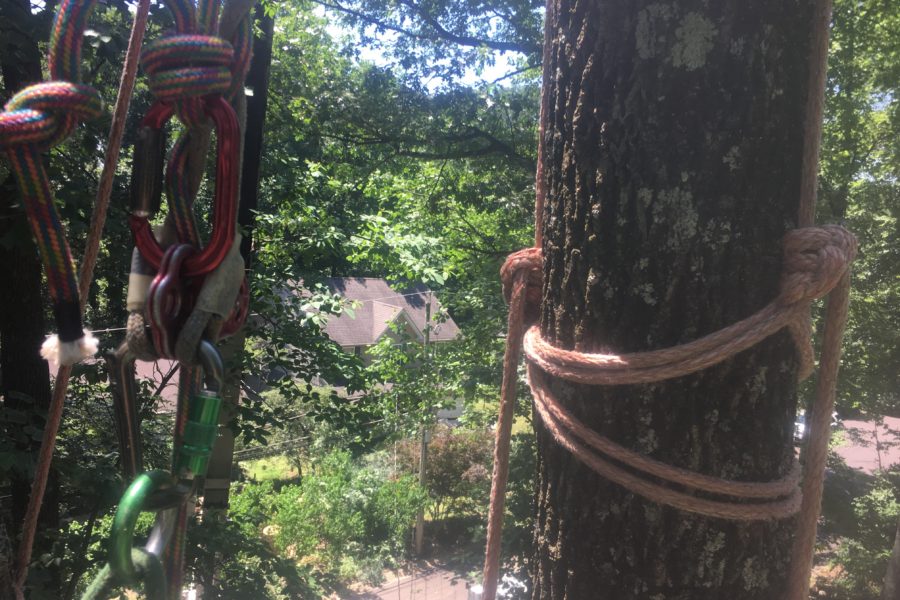Last week’s crane assisted removal job has ignited much thought into how I think about balance, as well as the load bearing capability of tree parts.
Rigging balanced, static picks in crane work is an art and science in both analyzing the strength and position of the crane, as well as the strength and position of the branches being rigged. Many of the picks we worked through in the white oak last week were anywhere between two thousand and four thousand pounds. But how is that dynamic load distributed throughout each of the balanced crane picks? Because of the critical need to balance each rig carefully, it is the climber’s job to also be critical about where we are attaching the rigging slings. In this sense, we see how intricate a role tree biomechanics plays in crane rigging operations.
Pete Nieves-Sosa from the The Crane Man, Inc. provided me with three Quantum-X dead-eye slings to utilize for balancing the load in each rig. In the horizontally sprawling, brushy sections of the white oak that we rigged, the challenge was typically in the execution of grabbing a meaty section of short trunk with one sling, and deploying the other two slings on smaller scaffold limbs in order to balance the load, while still maintaining strong integrity in the rigging. Pete’s advice to spread the load out evenly amongst the rigging, and “to grab as much as the triangle as possible,” is still echoing in my mind.
But there is a fine line between grabbing enough, and grabbing more than the particular tree part can handle. It is on this line that art and science converge in the world of crane-assisted tree work.
The Quantum-X slings have a MBS of upwards of 48,000 (WLL nearing 7,000 pounds). So then, this rating becomes a serious issue when rigging to a four or five inch scaffold limb, because the biomechanics of that limb will need to be able to handle the dynamic load of the pick once it is cut free from the stem. Given the vast variety of tree species and the particular characteristics of the wood strength in each individual, the idea of balance becomes seriously complex.
Crane rigging often requires critical balance (working around utilities and other unmovable targets), so there should also be a crucial analysis of the particular tree part’s biomechanics, or structural integrity with regards to the load it will be exposed to. Inspecting branch unions near the sling termination and also where the limb is attached to the trunk is an important consideration because of the extreme loads that these tree parts may experience. If one branch were to fail in a balanced crane pic, this could be a catastrophic event, throwing a balanced rig into chaos that could jeopardize the safety of everyone involved.
We are constantly questioning what the crane can lift from a specific position, but the consideration must also be made into what the maximum load of the tree part we are rigging to can bare. Bark inclusions, decay, and reaction growth in the form of callus or swelling could all mean that the interior structural integrity of a tree part may not be able to handle a load you are about to expose it to. What will that part be exposed to? Four hundred, five hundred, six hundred pounds? And can it handle that load threshold?
Just because the operator is good for seven thousand pounds doesn’t mean the tree can maintain it’s structural integrity approaching that threshold. Balance, in this sense, does not just mean a clean, triangulated sling placement that will steady the load of a given rating. It also means a balanced analysis of the integrity of the wood we capture in our rigging, and how the story of dynamic force will unfold as a piece is cut free and completely loaded onto the crane cable.
Strength (or rather, rigging/load capacity) is a double edged sword that should be sheathed in efficiency, sharpened with safety and wielded with communication and teamwork.





Leave a Reply
Your email is safe with us.